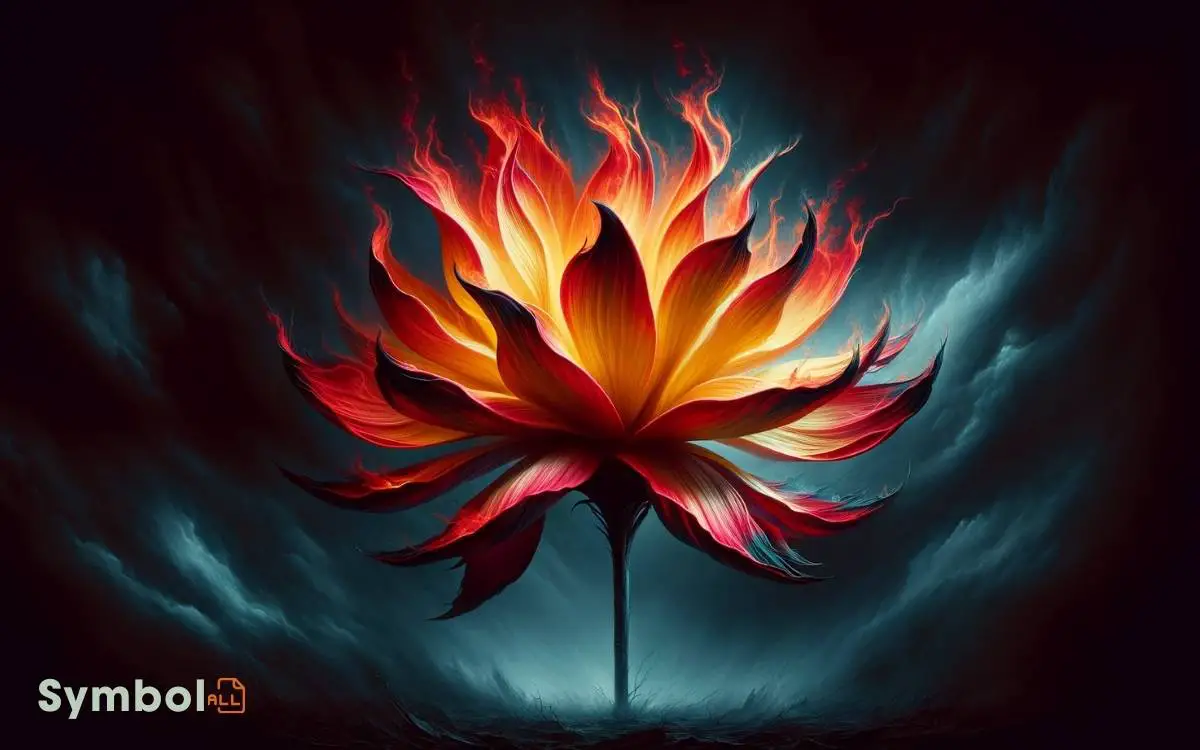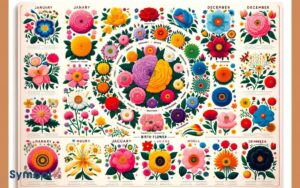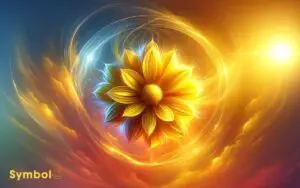Flower That Symbolizes Resentment and Anger: Marigold!
The Marigold flower symbolizes deep-seated resentment and anger. Its delicate petals reflect the warmth of creativity while harboring potent negative emotions.
Bright orange and yellow hues embody the sun’s energy, yet its association with resentment stems from its medicinal potency, demonstrating the flower’s ability to encompass the full emotional spectrum.
Historical and cultural significance highlights Marigold’s role in rituals for protection and healing, with its compounds contributing to its therapeutic properties. Its cultivation patterns show resilience and versatility, paralleling human psychological complexity.
Exploring further reveals a richer understanding of Marigold’s symbolic layers, offering insight into its enduring relevance.

Key Takeaways
The Symbolic Flower Revealed
One might find it surprising that the delicate petal marigold symbolizes not only warmth and creativity but also deep-seated resentment and anger, embodying a complex array of human emotions.
You’d observe in the pigment variations and growth patterns of the marigold an intriguing parallel to human psychological complexity. Its bright orange and yellow hues traditionally represent the sun’s energy, translating to creativity and motivation.
However, beneath this vibrant facade, the marigold’s association with negative emotions stems from its potent medicinal properties, which historically have been used in rituals to protect against harm and heal physical and emotional wounds.
This duality reflects the marigold’s capacity to embody both the light and dark aspects of our emotional spectrum, offering a nuanced perspective on how beauty can encapsulate a broader, more intricate range of feelings.
Historical Significance
The marigold’s historical significance stems from its extensive use in ancient cultural rituals, where it served as a potent symbol for protection and healing, reflecting its complex emotional symbolism.
This flower’s presence in medicinal and spiritual practices across different civilizations highlights its multifaceted roles beyond mere resentment and anger.
Analyzing the compounds within marigolds, such as lutein and zeaxanthin, reveals their contribution to the plant’s healing properties, which ancient societies recognized and utilized.
Additionally, its cultivation patterns, adapting across continents, demonstrate a resilience and versatility that further embed its significance in historical contexts.
Understanding marigolds through this lens allows you to appreciate the depth of its symbolic spectrum, where its association with negative emotions is but a facet of its broader historical and cultural relevance.
Cultural Interpretations
You’ll find that the historical origins of flowers symbolizing resentment and anger provide a foundation for understanding their global symbolic meanings.
This exploration reveals a variety of artistic representations across cultures, each adding a unique layer to the flower’s interpretative richness.
Analyzing these elements offers insights into the complex ways societies express and perceive emotional states through flora.
Historical Origins
Delving into the historical origins of flowers symbolizing resentment and anger reveals diverse cultural interpretations that vary greatly across different societies.
This exploration uncovers the nuanced ways in which flora have been employed to express complex human emotions.
Here are key aspects:
- Ancient Texts: References in ancient texts highlight how specific flowers were used in rituals and literature to convey negative emotions, including Homer’s epics and medieval European texts.
- Botanical Symbolism: The study of plants’ physical attributes, such as thorns or color, contributed to their symbolic meanings. Red, often associated with anger, played a significant role.
- Cultural Practices: Traditional uses of flowers in ceremonies or as gifts varied, with some cultures developing unique interpretations based on historical events or folklore.
Understanding these origins requires analyzing texts, botanical characteristics, and cultural practices to grasp the depth of symbolism.
Global Symbolic Meanings
Across cultures, flowers’ meanings vary greatly, revealing a rich tapestry of symbolic interpretations tied to resentment and anger.
In your quest to understand these global perspectives, recognizing that cultural context profoundly influences a flower’s connotation is crucial.
For instance, in some Eastern cultures, specific blooms symbolize anger due to their sharp thorns and harsh colors, serving as a metaphor for piercing emotions.
Conversely, Western traditions might associate certain flowers with resentment through historical events or literary references, embedding these meanings deeply into societal consciousness.
Analyzing these interpretations necessitates a detailed examination of cultural narratives, folklore, and even linguistic nuances that contribute to a flower’s symbolic role.
This multi-layered approach uncovers the complex ways flowers communicate nuanced emotions like resentment and anger across diverse global communities.
Artistic Representations
In numerous artistic mediums, flowers serve as potent symbols of resentment and anger, reflecting complex cultural interpretations that vary considerably from one society to another.
This symbolism manifests through:
- Visual Arts: Artists often employ specific flowers in paintings and sculptures to convey negative emotions, utilizing color theory and botanical characteristics to enhance the expression of disapproval or discord.
- Literature: In poetry and prose, flowers symbolize unspoken grievances and internal conflicts, enabling authors to explore deeper psychological and societal issues through botanical metaphors.
- Performative Arts: In theater and film, flowers can serve as visual cues or props to signify underlying tensions between characters, often foreshadowing conflicts or representing unhealed past injuries.
These representations demonstrate the flower’s capacity to communicate complex emotional states, offering insights into human nature and cultural values.
Botanical Characteristics
You’ll first explore the plant morphology overview, focusing on the unique physical structures that symbolize resentment and anger.
Next, you’ll examine its growth habitat to understand how environmental conditions influence its development and symbolic meanings.
Plant Morphology Overview
The plant’s morphology, characterized by its unique botanical features, plays a significant role in symbolizing resentment and anger.
To comprehend how, it’s crucial to analyze:
- Leaf Structure: The leaves are often sharp and angular, embodying a sense of cutting or piercing, which metaphorically represents the sharpness of resentment.
- Flower Form: Its flowers, usually with pointed petals or a stark, contrasting color pattern, visually evoke feelings of intensity and passion, mirroring the nature of anger.
- Stem and Thorn Presence: The plant’s stems may be rigid and covered in thorns, symbolizing defense and protection, an outward expression of internal turmoil and the need to guard against further harm.
These aspects contribute to the plant’s overall symbolism, providing a visual and botanical representation of complex emotions.
Growth Habitat Explained
Understanding the plant’s morphology offers insight into its symbolism; now, let’s explore how its growth habitat contributes to these meanings through specific botanical characteristics.
This plant thrives in harsh, challenging environments, symbolizing its resilience and the persistence of resentment and anger. It often occupies rocky, nutrient-poor soils, demonstrating its ability to survive and even flourish under adverse conditions.
This adaptability suggests a metaphor for holding onto negative emotions, which can persist in inhospitable emotional landscapes.
The plant’s preference for direct sunlight mirrors the idea that resentment and anger can grow under the scrutiny and heat of attention.
Its robust root system, capable of extracting water from seemingly barren terrain, further symbolizes the deep-seated nature of these emotions, difficult to eradicate once established.
Reproductive Features Insight
Delving into the plant’s reproductive features offers a deeper understanding of how its physical characteristics reflect the nuances of resentment and anger.
- Pollen Dispersal Mechanism: The plant’s method of pollen dispersal is highly selective, requiring specific pollinators that can navigate its complex structure. This exclusivity mirrors the targeted nature of resentment.
- Seed Germination: Its seeds exhibit a delayed germination process, symbolizing the simmering aspect of anger, which can lie dormant before emerging.
- Floral Morphology: The flower’s morphology, with sharp, angular petals and often dark, brooding colors, visually represents the emotion of anger. The structure serves not just aesthetic purposes but also safeguards the survival of the species by deterring herbivores, akin to how resentment might protect from further emotional harm.
Artistic Representations
Artists often depict the flower symbolizing resentment and anger, integrating it into various mediums to explore its complex emotional landscape. You’ll find it in paintings, sculptures, and digital art, each medium offering a unique lens through its representation.
Through meticulous brush strokes, sculptors’ careful chiseling, or digital artists’ precision, the inherent qualities of this flower are magnified, revealing layers of meaning.
These artistic renditions dissect its symbolism, often contrasting its aesthetic beauty with the darker emotions it embodies.
Analysts scrutinize these works, identifying the techniques artists use to evoke a sense of unease or discomfort, highlighting the flower’s dual nature.
Such detailed examinations reveal how color, form, and context contribute to interpreting the flower’s symbolic weight, enhancing our understanding of its place in art and symbolizing complex human emotions.
Modern Usage and Perceptions
In modern contexts, the flower symbolizing resentment and anger has seen a diverse range of interpretations and uses, reflecting broader societal shifts in the perception of negative emotions. You’ll find this flower’s presence intriguing due to its multifaceted symbolism.
Here are three key aspects:
- Psychological Studies: Research has shown that exposure to this flower may influence individuals’ emotional states, leading to a deeper understanding of how environment impacts mood and behavior.
- Therapeutic Uses: Therapists sometimes incorporate these flowers into sessions to help clients visually confront and process feelings of anger and resentment.
- Cultural Shifts: The flower’s symbolism is increasingly embraced in art and literature, reflecting a greater societal acceptance of discussing and expressing negative emotions, thereby demystifying and destigmatizing these feelings.
This detailed analysis reveals the evolving perceptions and applications of this symbol in contemporary society.
Care and Cultivation Tips
To successfully cultivate the flower symbolizing resentment and anger, you’ll need to adhere to specific environmental conditions, guaranteeing adequate sunlight, soil pH, and moisture levels.
Begin by testing the soil pH; this species thrives in slightly acidic to neutral soil, typically ranging from 6.0 to 7.0. Adjust the pH accordingly using sulfur to lower or lime to raise it.
Sunlight is critical—aim for full sun exposure, with at least six hours of direct sunlight daily. However, in hotter climates, partial afternoon shade will prevent scorching.
Regarding watering, maintain consistent moisture without waterlogging the soil. Implement a mulch layer to retain soil moisture and regulate temperature. Lastly, ensure good drainage to prevent root rot, a common issue in poorly drained soils.
Conclusion
With its petals poised in perennial pique, the symbolic flower you’ve now come to know not only embodies bitterness but blooms with a beauty that belies its deeper disdain.
Delving into its historical roots and cultural cues, you’ve uncovered an intricate tapestry of human emotions, mirrored in the botanical world.
As you consider its care, let its complex character challenge your perceptions, inviting a nuanced appreciation for the delicate dance between nature’s allure and its underlying allegories.






